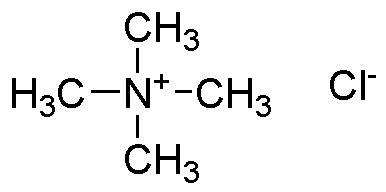Tetramethylammonium chloride is widely utilized in research focused on:
- Organic Synthesis: It serves as a phase transfer catalyst, enhancing the efficiency of reactions between organic and inorganic compounds, making it invaluable in the production of pharmaceuticals and agrochemicals.
- Electrochemistry: This compound is used in electrochemical studies, particularly in the development of batteries and fuel cells, due to its ability to improve ionic conductivity.
- Biotechnology: It plays a role in cell culture applications, where it can help maintain osmotic balance and improve cell viability, crucial for biopharmaceutical production.
- Analytical Chemistry: It is employed as a reagent in various analytical techniques, including chromatography, to enhance separation and detection of compounds.
- Surface Modification: The compound is used in modifying surfaces to improve properties such as hydrophobicity or biocompatibility, beneficial in materials science and medical device development.
General Information
Properties
Safety and Regulations
Applications
Tetramethylammonium chloride is widely utilized in research focused on:
- Organic Synthesis: It serves as a phase transfer catalyst, enhancing the efficiency of reactions between organic and inorganic compounds, making it invaluable in the production of pharmaceuticals and agrochemicals.
- Electrochemistry: This compound is used in electrochemical studies, particularly in the development of batteries and fuel cells, due to its ability to improve ionic conductivity.
- Biotechnology: It plays a role in cell culture applications, where it can help maintain osmotic balance and improve cell viability, crucial for biopharmaceutical production.
- Analytical Chemistry: It is employed as a reagent in various analytical techniques, including chromatography, to enhance separation and detection of compounds.
- Surface Modification: The compound is used in modifying surfaces to improve properties such as hydrophobicity or biocompatibility, beneficial in materials science and medical device development.
Documents
Safety Data Sheets (SDS)
The SDS provides comprehensive safety information on handling, storage, and disposal of the product.
Product Specification (PS)
The PS provides a comprehensive breakdown of the product’s properties, including chemical composition, physical state, purity, and storage requirements. It also details acceptable quality ranges and the product's intended applications.
Certificates of Analysis (COA)
Search for Certificates of Analysis (COA) by entering the products Lot Number. Lot and Batch Numbers can be found on a product’s label following the words ‘Lot’ or ‘Batch’.
*Catalog Number
*Lot Number
Certificates Of Origin (COO)
This COO confirms the country where the product was manufactured, and also details the materials and components used in it and whether it is derived from natural, synthetic, or other specific sources. This certificate may be required for customs, trade, and regulatory compliance.
*Catalog Number
*Lot Number
Safety Data Sheets (SDS)
The SDS provides comprehensive safety information on handling, storage, and disposal of the product.
DownloadProduct Specification (PS)
The PS provides a comprehensive breakdown of the product’s properties, including chemical composition, physical state, purity, and storage requirements. It also details acceptable quality ranges and the product's intended applications.
DownloadCertificates of Analysis (COA)
Search for Certificates of Analysis (COA) by entering the products Lot Number. Lot and Batch Numbers can be found on a product’s label following the words ‘Lot’ or ‘Batch’.
*Catalog Number
*Lot Number
Certificates Of Origin (COO)
This COO confirms the country where the product was manufactured, and also details the materials and components used in it and whether it is derived from natural, synthetic, or other specific sources. This certificate may be required for customs, trade, and regulatory compliance.


